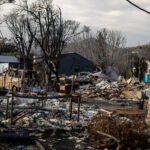Mindful that the suburban West Bank of New Orleans has regained its pre-Hurricane Katrina population and is primed for growth, the Army Corps of Engineers is launching a $1 billion effort to keep the next storm at bay.
The new flood protection is already having a potentially dangerous consequence, though: It’s encouraging more people to move into another bowl-shaped area that experts consider perhaps the city’s most vulnerable flank.
While New Orleans’ population plummeted by 300,000 after Katrina, residents quickly returned to the west bank of the Mississippi River, many under the mistaken impression that the area was safer.
The fact that the West Bank didn’t flood was mainly chance, however. Engineers say the area’s 250,000 residents are exposed to surge from a storm coming in at just the right angle, thanks in part to navigation and drainage canals that feed in.
So the corps broke ground last week on the West Closure Structure, a floodgate and pump system designed to close off those canals and bolster the area’s levees.
“The levees are a big deal. They’ve got to get them done,” said Rosemary Veitel, owner of a clothing boutique at the Fountain Park Centre, a new commercial development with fake swans, spewing fountains and Roman statues more at home in Phoenix or Las Vegas than on the edge of the Louisiana swamp.
Local officials see the West Closure Structure as the key to luring more business owners like Veitel.
“This is the yellow brick road to progress,” Aaron Broussard, the Jefferson Parish president, crowed at the groundbreaking ceremony for what the corps calls the West Closure Structure.
As the name implies, the West Bank is west of the Mississippi River and the French Quarter, in a place tourists pass through only if they’re on their way to swamp tours. So far, it has been spared catastrophic flooding. Katrina passed to the east in August 2005, and the West Bank was one of the only dry places in the city after levees failed on the East Bank, the main part of the metro area.
But after Katrina, hurricanes Rita and Gustav pushed water levels dangerously high in canals on the West Bank.
“When we had Gustav, we had water come in, but it was minor, thank God,” Veitel said.
Roy Dokka, the executive director of the Center for GeoInformatics at Louisiana State University, said up to 70 percent of the West Bank could be underwater if a monster storm were to hit it.
The West Bank project is one of two the corps is building to protect New Orleans, the other being a similar storm surge barrier on the East Bank that closes off the Inner Harbor Navigation Canal.
With large areas of the West Bank undeveloped pasture, woods and wetlands, the improved levee system will spur development, especially since most of the East Bank is crammed with houses and businesses.
“It’s the only land left for large populations to grow,” said state Rep. Ricky J. Templet, a Republican who represents a swath of the West Bank. “The sky’s the limit. On the West Bank, we were the last to get started on our flood protection. Some people will be able to sleep at night now.”
They shouldn’t sleep too soundly, according to Robert Bea, a civil engineer with the University of California, Berkeley, and an expert on the New Orleans levee system. Bea called the West Bank project an example of the corps’ flawed levee building policies, designed to handle a 100-year storm rather than shelter the area for many centuries like dikes in the Netherlands.
Bea’s advice to West Bank developers and homeowners: “Build high, build strong because the level of protection is not sufficient to build low and weak.”
If anything, though, building requirements will get more lax after the levee system is finished.
Tom Rodrigue, the flood plain manager for Jefferson Parish, said developers most likely would wait for the levees to be certified as acceptable by the Federal Emergency Management Agency before building. FEMA certification opens the door for cheaper flood insurance and building lower to the ground.
The Army Corps isn’t fazed by the potential for development in this vulnerable area.
“People tend to build and live around the coastal landscape, and that’s a natural thing for Southeast Louisiana regardless of whether you have the risk reduction in place or not,” said Tom Podany, the chief of the corps’ Protection and Restoration Office in New Orleans. “What (the levee system) does is recognize that’s going to happen and provide for a way to increase their safety.”
Counting the West Closure Structure, the corps is pouring more than $2 billion into finishing the long-overdue levee system on the West Bank. The agency now says it plans to have most of the West Bank hurricane protection done by 2011.
“On the East Bank, they had a complete system that failed. On the West Bank, we didn’t have a complete system to fail,” said Jerry Spohrer, a levee manager on the West Bank. By 2011, he said, “we should be buttoned up pretty tight – the first time on the West Bank, which is amazing.”
Was this article valuable?
Here are more articles you may enjoy.

 Abbott Presses Congress for Shield Over Preemie Baby Formula Litigation That Could Cost It Billions
Abbott Presses Congress for Shield Over Preemie Baby Formula Litigation That Could Cost It Billions  Truckers Who Fail English Tests Get Pulled Off Roads in Trump Crackdown
Truckers Who Fail English Tests Get Pulled Off Roads in Trump Crackdown  California Again Delays Wildfire Protection Rules for Homes
California Again Delays Wildfire Protection Rules for Homes  Zillow Deleting Climate Risk Scores Reveals Limits of Flood, Fire Data
Zillow Deleting Climate Risk Scores Reveals Limits of Flood, Fire Data 